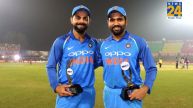The International Cricket Council (ICC) is considering a series of substantial reforms to the game, looking to enhance balance between bat and ball as well as speeding up the game. Among the proposals being seriously considered is phasing out the two-new-ball rule in One-Day Internationals (ODIs), with the aim of reviving the skill of reverse swing, something which has grown very rare in contemporary limited-overs cricket.
Instead of abandoning the existing playing conditions entirely, the ICC is said to be coming up with a hybrid model. According to sources, as per the new proposal, matches would continue to start with two new balls — one from each end — but only one ball would be utilized from the 25th over onwards. The fielding side would be free to decide which ball they would use for the rest of the innings.
The advice is believed to have been recommended by the ICC’s Cricket Committee, headed by former India captain Sourav Ganguly, and is likely to be discussed when the meetings take place in Zimbabwe.
The aim is to allow the ball to age naturally, providing conditions favoring reverse swing — particularly in the late overs — which for many has been lost as a consequence of the two-ball rule. Presently, every ball is used only for 25 overs, and consequently they still have their shine and hardness for a much longer time, making it hard for bowlers to get reverse swing.
A number of former players have expressed dismay over this, one of them being cricket great Sachin Tendulkar, who had previously described the two-ball rule as a “perfect recipe for disaster.”
“We have not witnessed reverse swing, which is a big part of death overs, for a very long time,” Tendulkar had said in a social media post. He and former seamer Brett Lee have been longtime proponents of reintroducing balance between bat and ball in the ODI format.
With the new system in place, the ball would spend a maximum of 37 or 38 overs on the pitch — nearly approaching the traditional standard when white balls were not routinely changed — quite possibly reinstating the type of wear and tear that facilitates reverse swing without heavily degrading appearance or condition.
The ICC is likewise considering the feasibility of introducing clocking for Test cricket over rates, with 60 seconds considered as the acceptable time between overs. The clock has already gained success in their shorter versions, where it’ve accelerated proceedings.
The plan is part of the ICC’s wider drive to make sure the entire quota of 90 overs is bowled every day of a Test match. With slow over rates and delays a constant problem in red-ball cricket, officials hope the addition of a visible countdown will help speed up the changeovers between overs.
U-19 Men’s World Cup May Switch to T20 Format
The other significant alteration being considered is the potential transition of the Men’s Under-19 World Cup from the 50-over to the T20 format. Although the tournament has historically been used as a platform for young cricketers to transition to ODI cricket, more and more administrators believe that keeping it aligned with the more popular T20 format is the way forward, particularly considering the success of the Women’s U-19 T20 World Cup.
The women’s tournament has already been conducted in the T20 format, with editions in 2023 (South Africa) and 2025 (Malaysia), and the men’s version may follow suit. But any such change would not happen before the next broadcast cycle, which starts in 2028.
Also Read: IPL 2025: ‘TRAITOR!’ MS Dhoni Calls THIS Former CSK Star During Practice Session – Watch Video













